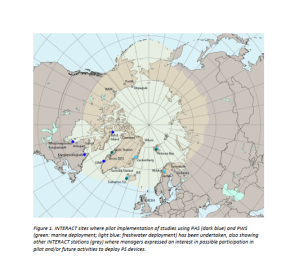 INTERACT WP 8, Cleaner ArcticDefinitions of the Arctic vary according to environmental, geographical, political, cultural and scientific perspectives. Some scientists define the Arctic as areas having a high latitude, long winters, short, cool summers,... More, cleaner world: documenting and reducing pollution, has submitted a news deliverable: D8.4 – Plan for development of screening monitoring networks and enhancing application of screening monitoring, to be downloaded below.
INTERACT WP 8, Cleaner ArcticDefinitions of the Arctic vary according to environmental, geographical, political, cultural and scientific perspectives. Some scientists define the Arctic as areas having a high latitude, long winters, short, cool summers,... More, cleaner world: documenting and reducing pollution, has submitted a news deliverable: D8.4 – Plan for development of screening monitoring networks and enhancing application of screening monitoring, to be downloaded below.
Over the past three decades, the ArcticDefinitions of the Arctic vary according to environmental, geographical, political, cultural and scientific perspectives. Some scientists define the Arctic as areas having a high latitude, long winters, short, cool summers,... More Monitoring and Assessment Programme (AMAPArctic Monitoring and Assessment Programme. One of the working groups of the Arctic Council. Established in 1991. AMAP is responsible for measuring the levels of pollutants in the Arctic, and... More) has documented the presence and impact of chemical contaminants in the ArcticDefinitions of the Arctic vary according to environmental, geographical, political, cultural and scientific perspectives. Some scientists define the Arctic as areas having a high latitude, long winters, short, cool summers,... More, helping shape policies aimed at reducing pollution. The 2017 AMAPArctic Monitoring and Assessment Programme. One of the working groups of the Arctic Council. Established in 1991. AMAP is responsible for measuring the levels of pollutants in the Arctic, and... More assessment highlighted Chemicals of Emerging ArcticDefinitions of the Arctic vary according to environmental, geographical, political, cultural and scientific perspectives. Some scientists define the Arctic as areas having a high latitude, long winters, short, cool summers,... More Concern (CEACs), which include new, often unstudied chemicals that are difficult to analyze. Some are transported long distances to the ArcticDefinitions of the Arctic vary according to environmental, geographical, political, cultural and scientific perspectives. Some scientists define the Arctic as areas having a high latitude, long winters, short, cool summers,... More, while others come from local sources like consumer products and industrial activity. Climate changeAccording to the United Nations Framework Convention on Climate Change, climate change is change in the climate of the whole Earth or a region of the Earth that is believed... More is further complicating the issue by altering contaminant pathways and potentially releasing previously trapped pollutants. Human activities and resource exploration in the ArcticDefinitions of the Arctic vary according to environmental, geographical, political, cultural and scientific perspectives. Some scientists define the Arctic as areas having a high latitude, long winters, short, cool summers,... More are also on the rise, increasing chemical usage. INTERACT WP8 has identified chemicals for coordinated research and monitoring efforts, deploying passive samplers across nine research stations. The final report recommends steps to support ongoing monitoring and inform agencies about potential threats from these pollutants.
